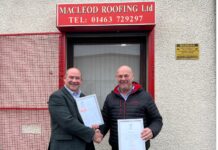
Rooflight leakage, left unattended, can lead to a multitude of potentially costly repairs. Although not always the fault of product design, installing quality rooflighting reduces long-term risk of structural damage, rotted roof sheathing, rooted roof framing and wet, mouldy insulation. Getting the specification right first time is paramount to a rooflight’s lifetime effectiveness. Richard Burgess, business owner of manufacturer Lonsdale Patent Glazing & Rooflights, explains the issues to consider when seeking out and installing a quality system
WITH a market-leading range of patent glazing and rooflights, Lonsdale Metal offers a variety of solutions designed to meet traditional aesthetic demands, stringent planning restrictions and contemporary Building Regulations.
From SpanGard self-supporting aluminium lanterns and skylights; neat box bar design of ThermGard thermal glazing bars, and low cost, high performance rooflight for flat roof applications, EcoGard; Lonsdale has the expertise to determine the very best, high performance specification and glass combinations for every domestic and commercial project.
STRONG SILENT TYPES
Whatever the aspirations of the rooflight system – light transmission, thermal efficiency or sound insulation – designers must take into account a whole host of elements including light, heat, ventilation, strength and maintenance.
From infill types to glazing bar widths, it’s crucial to get each aspect of the specification right to deliver optimum performance throughout the system’s lifetime and prevent costly failures in the future.
Specifying the glass type is one of the key stages of the process. With a huge range of infills available – including clear, translucent and opaque panels in glass, polycarbonate or GRP – the designer must consider the height of the building, the size of the rooflight and the use of the space below.
For domestic projects price remains an important consideration and it’s important to choose the best performing glass to give excellent all year round comfort.
Commercial projects have different considerations, but again emphasis should be placed on best value and availability to avoid long lead times and to keep costs down in the event of replacement.
When two sheets of glass are bonded together with an interlayer, this forms laminated glass. Although this glass is still breakable, it is actually a little stronger than in its original form, and simply cracks and remains in place due to the bonded interlayer. Commonly used in the motor industry for car windscreens, laminated glass is also used as single glazing for canopies, walkways, railway platform glazing and other unheated spaces.
Toughened glass is manufactured through a heating process that uses controlled thermal or chemical treatments to increase its strength compared with normal glass.
When broken, the glass crumbles into small granular chunks of similar size and shape instead of splintering into random, jagged shards.
Wired safety glass enables classification to BS6206 Class C Safety Rating, while normal ‘wired glass’ is not suitable.
Used since the end of the 19th century for overhead glazing, the wires hold together any broken pieces of glass providing a similar, but not as efficient function as the PVB interlayer on laminated glass.
As a superior version of wired glass, the safety version provides fire resistance but care must be taken to ensure the system provides the required half hour or one hour protection.
CLEAN AND CLEAR
Rooflight designers should seriously consider cleaning and maintenance obligations before installation to ensure any glazing system can be safely cleaned throughout its life cycle. It is important to clean both the glass and aluminium system to prevent the build-up of grime and debris in order to maintain good light transmission.
In addition, any architectural finishes must be cleaned in accordance with the manufacturer’s instructions to ensure any warranty remains valid.
GET IT RIGHT FIRST TIME
Paramount to the longevity of a rooflight’s weather-tightness is to ensure robust installation details in the first place.
The abutments with the building must be correctly flashed not only to withstand driving rain, but ingress of water due to capillary action.
Lonsdale recommends any flashing – be it aluminium or lead – be flashed onto the glazing by a minimum of 50mm, but ideally no more than 100mm otherwise there is a risk of thermal cracking due to uneven expansion of the glass.
Similarly, the minimum recommended pitch for sloped patent glazing is 15 degrees. If below this, it is important to seal the flashings to the infill to prevent leaks.
‘Flat’ rooflights such as EcoGard remain fitted at 5 degrees to ensure water does not lay on the rooflight which is unsightly and causes dirt to build up over time and the amount of light transmission to deteriorate.
In addition, low pitch rooflights under 10 degrees should feature watertight structural silicone glazing to seal the joints between the glass, rather than cappings and gasket which may prove ineffective in exposed locations.
It’s an age-old saying but with rooflights it is true – you get what you pay for.
High quality rooflight systems will combine a long design life with low maintenance to deliver a glass roof that is built to stand the test of time.











